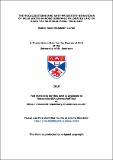Files in this item
The vocalisations and anti-predatory behaviour of wild white-handed gibbons (Hylobates lar) in Khao Yai National Park, Thailand
Item metadata
| dc.contributor.advisor | Zuberbühler, Klaus | |
| dc.contributor.author | Clarke, Esther A. E. | |
| dc.coverage.spatial | 233 | en_US |
| dc.date.accessioned | 2011-03-17T09:19:53Z | |
| dc.date.available | 2011-03-17T09:19:53Z | |
| dc.date.issued | 2010 | |
| dc.identifier.uri | https://hdl.handle.net/10023/1688 | |
| dc.description.abstract | The loud songs of gibbons (Hylobatidae) usually consist of a duet by the mated pair delivered each morning. These songs can transmit over a kilometre through dense forest habitat and therefore presumably play a role in long-distance communication. There is some evidence to suggest that gibbons use song in contexts other than their daily duets, such as predation, but these songs have not been well studied. Close- range communication is also relevant for gibbons, but these quieter calls have completely escaped any detailed observation. The responses of wild white-handed gibbons (Hylobates lar) to simulated visual and acoustic predators (tiger, clouded leopard, reticulated python and crested serpent eagle) were studied in Khao Yai National Park, Thailand to address the lack of empirical data about these important events. Little is known about gibbons’ anti- predatory behaviour in general, and simulated predator encounters provided an opportunity to investigate these responses as well. Results showed that gibbons used song as part of their anti-predator strategy and that subtle combinatorial changes were meaningful to conspecifics. They also showed marked behavioural changes in the short-term, and some evidence of longer-term changes as well. Quiet calls were also part of the gibbons’ response repertoire with the hoo call being particularly relevant. Hoos were used as a prelude to singing both normal duets and predator songs, but there were consistent differences between each context. Hoos were also delivered independently in a number of other contexts outside predation. When analysed, these hoos showed consistent contextual differences in a number of spectral parameters. Within the duet context, important contextual subtleties were evident also revealing a remarkable vocal plasticity. In addition, gibbons voluntarily attended to specific vocal elements of other gibbon duets, indicating that certain sequences are more pertinent than others. Results suggest both gibbon song and gibbon hoos are powerful communication tools that reliably reference external objects and events; this ability is also a critical feature of human language. | en_US |
| dc.language.iso | en | en_US |
| dc.publisher | University of St Andrews | |
| dc.subject.lcc | QL737.P96C6 | |
| dc.subject.lcsh | Whitehanded gibbon--Thailand--Vocalization | en_US |
| dc.subject.lcsh | Whitehanded gibbon--Thailand--Defenses | en_US |
| dc.subject.lcsh | Whitehanded gibbon--Thailand--Behavior | en_US |
| dc.title | The vocalisations and anti-predatory behaviour of wild white-handed gibbons (Hylobates lar) in Khao Yai National Park, Thailand | en_US |
| dc.type | Thesis | en_US |
| dc.type.qualificationlevel | Doctoral | en_US |
| dc.type.qualificationname | PhD Doctor of Philosophy | en_US |
| dc.publisher.institution | The University of St Andrews | en_US |
This item appears in the following Collection(s)
Items in the St Andrews Research Repository are protected by copyright, with all rights reserved, unless otherwise indicated.

